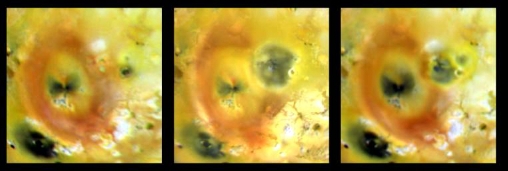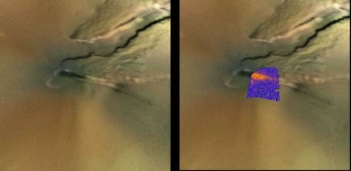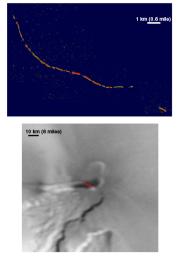Pele
Io's most distinctive feature is unquestionably the volcanic center, Pele. Pele is the site of an ongoing, high-velocity volcanic eruption. Deposits of sulfurous materials from Pele's plume are ejected out to more than 600 km (375 miles) from the vent. Its plume is nearly invisible, except in back-lit photographs, and it is thought to be an example of a stealth plume. Stealth plumes occur when the sulfur dioxide gas in the volcanic vent is at a very high temperature. Upon being expelled from the vent, the gas rapidly expands resulting in an undetectable, high-velocity jet of cold gas from which no snow is produced.

A dramatic display of how quickly volcanic activity can change the face of Io is shown in these three images of the Pillan Patera region near Pele. The images show the changes that occurred between April 1997 and July 1999. The image on the left was taken in April 1997. By September 1997 (center), a huge eruption occurred which produced a new dark spot the size of Arizona around the volcanic center named Pillan Patera. This eruption obscured a portion of Pele's red ring. By July of 1999 (left), red sulfurous material had once again begun to cover a portion of the dark material around Pillan, but had not yet been obscured it. This may be an indication that both the Pele and the Pillan plumes were still active. Another change in the 1999 image shows that a small volcano had erupted to the right of Pillan depositing dark material surrounded by a yellow ring.
 This
is a temperature map of the Pele region imaged by the
infrared spectrometer onboard the Galileo spacecraft. Red
indicates the hottest lava flows, and purple represents
cooler areas. The hottest lava flow temperatures recorded
are approximately 1400 K (2000 Fahrenheit), which is similar
to the temperatures of basaltic flows found on Hawaii's
Kilauea volcano.
This
is a temperature map of the Pele region imaged by the
infrared spectrometer onboard the Galileo spacecraft. Red
indicates the hottest lava flows, and purple represents
cooler areas. The hottest lava flow temperatures recorded
are approximately 1400 K (2000 Fahrenheit), which is similar
to the temperatures of basaltic flows found on Hawaii's
Kilauea volcano.
 This
image shows an outline of fresh, hot lava that follows the
margin of Pele's caldera. Scientists believe that the Pele
caldera is filled with liquid lava and has a floating crust.
The lava lake appears to be confined to the dark southern
part of the caldera which covers an area of about 15 km by
10 km (10 miles by 6 miles). Most of the lava lake is
covered by a cooler crust that floats on top of the molten
lava. The behavior of this lake is similar to that of
Hawaiian lava lakes, although Pele's lake covers an area
several thousand times larger than the lava lakes in Hawaii.
This
image shows an outline of fresh, hot lava that follows the
margin of Pele's caldera. Scientists believe that the Pele
caldera is filled with liquid lava and has a floating crust.
The lava lake appears to be confined to the dark southern
part of the caldera which covers an area of about 15 km by
10 km (10 miles by 6 miles). Most of the lava lake is
covered by a cooler crust that floats on top of the molten
lava. The behavior of this lake is similar to that of
Hawaiian lava lakes, although Pele's lake covers an area
several thousand times larger than the lava lakes in Hawaii.
